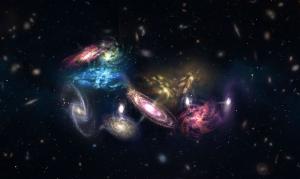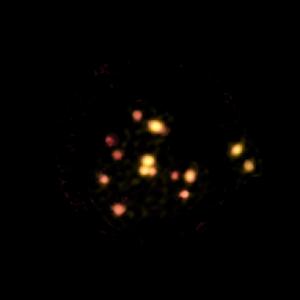Blog
An Early Meeting
2 May 2018
 NRAO/AUI/NSF; S. Dagnello
NRAO/AUI/NSF; S. DagnelloThroughout the universe, things tend to cluster together. Stars cluster together in galaxies, and galaxies form into clusters and superclusters. Galaxies form into clusters because the gravitational tug on each other tends to pull them together, while dark energy tends to separate clusters from each other. This pushme-pullyou of dark matter and dark energy clumps galaxies together. The clustering of galaxies takes time, so we wouldn’t expect to see large galaxies clusters in the very early universe. But it turns out some galaxy clusters can form rather quickly.
 ALMA (ESO/NAOJ/NRAO); B. Saxton (NRAO/AUI/NSF)
ALMA (ESO/NAOJ/NRAO); B. Saxton (NRAO/AUI/NSF)Recent observations1 by the ALMA telescope have found a group of more than a dozen galaxies in the early stages of cluster formation. Known as a protocluster, they eventually form the core of large galaxy superclusters. The protocluster is so distant that we see it at a time when the universe was only 1.4 billion years old. When the universe was only 10% of its current age, these galaxies were already huddled together into a region of space only three times wider than our own Milky Way.
This poses a challenge for galaxy cluster models. Computer simulations of the early universe predict that such protoclusters should take much longer to form than 1.4 billion years. It’s possible that this cluster is just a rare fluke, but it’s also possible that our computer models need to be revised.
T.B. Miller, et al. “A massive core for a cluster of galaxies at a redshift of 4.3” Nature vol556, pages469–472 (2018). ↩︎